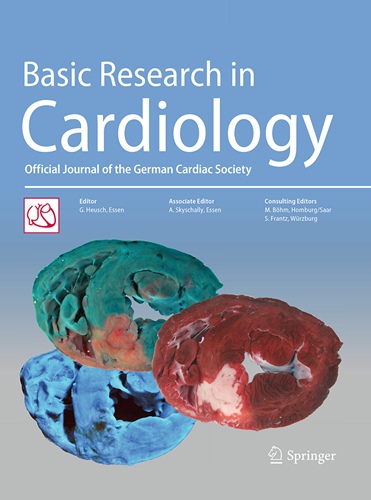心脏钠-葡萄糖共转运蛋白1 (SGLT1)参与糖尿病性心肌病小鼠模型的心力衰竭。
IF 8
1区 医学
Q1 CARDIAC & CARDIOVASCULAR SYSTEMS
引用次数: 0
摘要
糖尿病可导致心肌病独立于其他危险因素,如冠状动脉疾病和高血压,高达75%的患者。糖尿病性心肌病在人群中的患病率为1.1%。我们之前发现SGLT1在心肌细胞中表达,并在糖尿病性心肌病和其他形式的心力衰竭中进一步上调。在这项研究中,我们试图确定心脏SGLT1参与糖尿病、肥胖和胰岛素抵抗心衰病理生理的机制。我们确定心肌细胞特异性敲低SGLT1 (TGSGLT1-DOWN)的转基因小鼠在8-28周龄暴露于高脂饮食(HFD)诱导肥胖和胰岛素抵抗后,是否会减弱心肌病。暴露于HFD后,TGSGLT1-DOWN小鼠和野生型(WT)幼崽表现出相似的体重和血糖增加。然而,TGSGLT1-DOWN小鼠表现出心肌病的衰减,表现为肥厚减少、收缩和舒张功能障碍、纤维化、烟酰胺腺嘌呤二核苷酸磷酸氧化酶2 (Nox2)激活和活性氧(ROS)产生。体内高胰岛素血症和体外暴露于高糖或胰岛素的心肌细胞通过增加转录因子HNF-1和Sp1与SGLT1基因(Slc5a1)的结合,以及转录稳定剂HuR与SGLT1 mRNA的结合,导致SGLT1表达增加。SGLT1可能通过与EGFR的相互作用刺激ROS,从而导致肥胖和胰岛素抵抗的心脏损伤。SGLT1可能是抑制预防或逆转糖尿病性心肌病的治疗靶点。本文章由计算机程序翻译,如有差异,请以英文原文为准。
Cardiac sodium-glucose co-transporter 1 (SGLT1) contributes to heart failure in a mouse model of diabetic cardiomyopathy.
Diabetes mellitus can lead to a cardiomyopathy independent of other risk factors such as coronary artery disease and hypertension, in up to 75% of patients. The prevalence of diabetic cardiomyopathy in the population is 1.1%. We previously showed that SGLT1 is expressed in cardiomyocytes and is further upregulated in diabetic cardiomyopathy and other forms of heart failure. In this study, we sought to determine the mechanisms by which cardiac SGLT1 contributes to the pathophysiology of heart failure in diabetes, obesity, and insulin resistance. We determined whether transgenic mice with cardiomyocyte-specific knockdown of SGLT1 (TGSGLT1-DOWN) had attenuation of cardiomyopathy after induction of obesity and insulin resistance by exposure to a high fat diet (HFD) from ages 8-28 weeks. TGSGLT1-DOWN mice and wildtype (WT) littermates exhibited similar increases in body weight and blood glucose after exposure to HFD. Nevertheless, TGSGLT1-DOWN mice exhibited attenuation of cardiomyopathy, manifested by less hypertrophy, systolic and diastolic dysfunction, fibrosis, nicotinamide adenine dinucleotide phosphate oxidase 2 (Nox2) activation, and reactive oxygen species (ROS) production. In vivo hyperinsulinemia and in vitro exposure of cardiomyocytes to high glucose or insulin led to an increase in SGLT1 expression by increasing binding of the transcription factors HNF-1 and Sp1 to the SGLT1 gene (Slc5a1), and the transcript stabilizer HuR to SGLT1 mRNA. SGLT1 may contribute to cardiac injury in obesity and insulin resistance by stimulating ROS through its interaction with EGFR. SGLT1 may represent a therapeutic target for inhibition to prevent or to reverse diabetic cardiomyopathy.
求助全文
通过发布文献求助,成功后即可免费获取论文全文。
去求助
来源期刊

Basic Research in Cardiology
医学-心血管系统
CiteScore
16.30
自引率
5.30%
发文量
54
审稿时长
6-12 weeks
期刊介绍:
Basic Research in Cardiology is an international journal for cardiovascular research. It provides a forum for original and review articles related to experimental cardiology that meet its stringent scientific standards.
Basic Research in Cardiology regularly receives articles from the fields of
- Molecular and Cellular Biology
- Biochemistry
- Biophysics
- Pharmacology
- Physiology and Pathology
- Clinical Cardiology
 求助内容:
求助内容: 应助结果提醒方式:
应助结果提醒方式:


